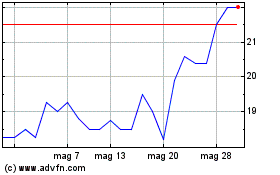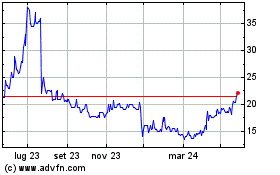Resource Update
08 Agosto 2008 - 9:55AM
UK Regulatory
RNS Number : 9423A
Berkeley Resources Limited
08 August 2008
8 August 2008
INITIAL RESOURCE OF 9.23 million pounds
at THE GAMBUTA DEPOSIT
The Directors of Berkeley Resources Limited (AIM: BKY.L) are pleased to announce an initial inferred resource estimate of 9.23 million
pounds of U3O8, at an average grade of 371ppm U3O8 (at a 200ppm cutoff), for the Gambuta uranium deposit in the Ceres Province of Spain.
The deposit remains open along strike to the north-west however, drilling has ceased during the current fire season.
It is anticipated that drilling to test the considerable strike potential beneath Tertiary and Quaternary cover to the northwest will
resume in early October.
Background
The Gambuta deposit occurs within the Caceres VI license and is located 165kms west-southwest of Madrid, about 20kms south of the
Badajoz - Madrid freeway and 6 kms east of the village of Bohonal de Ibor. It is typical of a number of perigranitic, shale hosted uranium
mineral occurrences within the Caceres VI licence, such as El Zarzal and Ojaranzo, located in the central and eastern part of the tenement
respectively. Additional targets for uranium, exploration have been identified in adjacent areas.
Gambuta is associated with an area of anomalous radiometrics defined by the Junta de Energia Nuclear (JEN) in the 1960's and briefly
explored by CISA (a joint venture between COGEMA (now AREVA) and ENUSA (Empresa Nacional Uranio S.A.)) in the early 1990's. Roto percussion
drilling by CISA (24 holes) identified a mineralised, north-westerly trending, structural zone with dimensions of approximately 900m x 400m,
including a central untested area of Tertiary cover.
A 36 hole program by Berkeley has confirmed the CISA results and defined a continuous, structurally controlled, zone of mineralisation
which is 250 - 350m wide, up to 94m below surface (see Figure 3) and is continuous for 1,500m in a west-northwesterly direction. This zone
appears to extend beneath Tertiary and Quaternary cover to the north-west and about 1,300m of untested strike potential remains within the
license.
Uranium mineralisation occurs within a sequence of strongly deformed Proterozoic spotted and banded grey to black phyllites which have
been contact metamorphosed by Hercynian granites. The contacts between the phyllites and the granite to the east and northeast are tectonic.
The sequence of host phyllites at Gambuta is similar to that hosting the Retortillo deposit in the Salamanca I license.
As at Retortillo, the Gambuta uranium mineralisation is generally sub-horizontal and associated with the weathering profile; a similar
model of formation is envisaged. Most mineralisation occurs in the zone of partial oxidation. Deeper mineralisation is associated with
oxidation along steeply dipping shears and fractures, dominantly sub-parallel to the mineralised trends. Uranium mineralisation occurs
within the schistosity, particularly in zones of shearing and fracturing. The only visible uranium minerals are secondary autunite and
torbernite.
The main mineralised horizon averages 9.4m in thickness and occurs at an average depth of 18.0m, beneath Tertiary cover and shales. A
lower mineralised horizon averages 2.1m in thickness and is separated from the main horizon by 16.3m of shales. A central, higher grade
(+0.1% U3O8,) zone, about 100m wide, is evident in the north-western half of the deposit and is open along strike.
Resource Calculation
All drilling results for the deposit have been previously reported in Stock Exchange announcements on 10 April, 6 June and 31 July 2008.
Assessment and interpretation of the historical and Berkeley drilling information was undertaken by Company geologists and resource
modelling was assisted by McDonald Speijers, a consulting group with more than 15 years experience in resource calculations. Resources were
calculated by block modelling methods, using an inverse distance squared method of grade distribution, and cross-checked using kriging
methods. The resource classification has been completed in accordance with the JORC Code. Grades were estimated using a calculated U3O8
value from total uranium as determined by Delayed Neutron Count, determined by Actlabs (Canada) with associated duplicates, blanks and
standards.
Of necessity, the block model employed large block sizes (25m x 25m x 2m) consistent with the wide-spaced location of drillholes, within
a wireframe defined by the interpretation of geological, radiometric and weathering data. This has resulted in some "spreading" of the grade
and subsequent infill drilling is expected to result in a more realistic grade distribution. Incorporation of variable densities was based
on measurements on selected core samples from diamond drill core, using the wet dry method.
Initial inferred uranium resources for the Gambuta deposit have been calculated as follows:
At a 200ppm U3O8 cut-off,
11.29Mt of ore at a grade of 371ppm U3O8 containing 9.23Mlbs U3O8
At a 150ppm U3O8 cut-off,
15.49Mt of ore at a grade of 318ppm U3O8 containing 10.85Mlbs U3O8
At a 100ppm U3O8 cut-off,
19.46Mt of ore at a grade of 278ppm U3O8 containing 11.95Mlbs U3O8
.
Future work
The next round of RC and diamond drilling will commence at the end of the high risk fire season, which is anticipated to be early in
October. This program will focus on defining the north-westerly extent of the deposit, where topography indicates potential for extensions
beneath Tertiary and Quaternary cover for a further 1.3km.
Infill drilling will be undertaken as required to better define the limits of mineralisation, in particular, the central zone of higher
grade mineralisation.
Diamond drilling will initially be directed to acquiring material for metallurgical testwork.
Enquiries - Managing Director: Matt Syme Tel: +61 417 906 717
RBC Capital Markets: Martin Eales Tel: +44 20 7029 7881
This information is provided by RNS
The company news service from the London Stock Exchange
END
MSCSSDSWASASEIA
Grafico Azioni Berkeley Energia (LSE:BKY)
Storico
Da Giu 2024 a Lug 2024

Grafico Azioni Berkeley Energia (LSE:BKY)
Storico
Da Lug 2023 a Lug 2024
